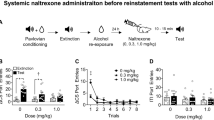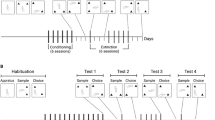Abstract
Conditioned opiate withdrawal contributes to relapse in addicts and can be studied in rats by using the opiate withdrawal–induced conditioned place aversion (OW-CPA) paradigm. Attenuation of conditioned withdrawal through extinction may be beneficial in the treatment of addiction. Here we describe a protocol for studying OW-CPA extinction using a two-chambered place conditioning apparatus. Rats are made dependent on morphine through subcutaneous implantation of morphine pellets and then are trained to acquire OW-CPA through pairings of one chamber with naloxone-precipitated withdrawal and the other chamber with saline. Extinction training consists of re-exposures to both chambers in the absence of precipitated withdrawal. Rats tested after the completion of training show a decline in avoidance of the formerly naloxone-paired chamber with increasing numbers of extinction training sessions. The protocol takes a minimum of 7 d; the exact duration varies with the amount of extinction training, which is determined by the goals of the experiment.
This is a preview of subscription content, access via your institution
Access options
Subscribe to this journal
Receive 12 print issues and online access
$259.00 per year
only $21.58 per issue
Buy this article
- Purchase on Springer Link
- Instant access to full article PDF
Prices may be subject to local taxes which are calculated during checkout



Similar content being viewed by others
References
Koob, G.F. & LeMoal, M. Drug abuse: hedonic homeostatic dysregulation. Science 278, 52–58 (1997).
Childress, A.R., McLellan, A.T. & O'Brien, C.P. Abstinent opiate abusers exhibit conditioned craving, conditioned withdrawal and reductions in both through extinction. Br. J. Addict. 81, 655–660 (1986).
O'Brien, C.P., Testa, T., O'Brien, T.J., Brady, J.P. & Wells, B. Conditioned narcotic withdrawal in humans. Science 195, 1000–1002 (1977).
Heather, N., Stallard, A. & Tebbutt, J. Importance of substance cues in relapse among heroin users: comparison of two methods of investigation. Addict. Behav. 16, 41–49 (1991).
Wikler, A. Recent progress in research on the neurophysiologic basis of morphine addiction. Am. J. Psychiatry 105, 329–338 (1948).
Siegel, S. & Ramos, B.M. Applying laboratory research: drug anticipation and the treatment of drug addiction. Exp. Clin. Psychopharmacol. 10, 162–183 (2002).
Amitai, N., Liu, J. & Schulteis, G. Discrete cues paired with naloxone-precipitated withdrawal from acute morphine dependent elicit conditioned withdrawal responses. Behav. Pharmacol. 17, 213–222 (2006).
Goldberg, S.R., Woods, J.H. & Schuster, C.R. Morphine: conditioned increases in self-administration in rhesus monkeys. Science 166, 1306–1307 (1969).
Kenny, P.J., Chen, S.A., Kitamura, O., Markou, A. & Koob, G.F. Conditioned withdrawal drives heroin consumption and decreases reward sensitivity. J. Neurosci. 26, 5894–5900 (2006).
Manning, F.J. & Jackson, M.C. Jr. Enduring effects of morphine pellets revealed by conditioned taste aversion. Psychopharmacology 51, 279–283 (1977).
Mucha, R.F. What is learned during opiate withdrawal conditioning? Evidence for a cue avoidance model. Psychopharmacology 104, 391–396 (1991).
Mucha, R.F., van der Kooy, D., O'Shaughnessy, M. & Bucenieks, P. Drug reinforcement studied by the use of place conditioning in rat. Brain Res. 243, 91–105 (1982).
Parker, L.A., Cyr, J.A., Santi, A.N. & Burton, P.D. The aversive properties of acute morphine dependence persist 48 h after a single exposure to morphine: evaluation by taste and place conditioning. Pharmacol. Biochem. Behav. 72, 87–92 (2002).
Frenois, F., Cador, M., Caille, S., Stinus, L. & Le Moine, C. Neural correlates of the motivational and somatic components of naloxone-precipitated morphine withdrawal. Eur. J. Neurosci. 16, 1377–1389 (2002).
Frenois, F., Stinus, L., Di Blasi, F., Cador, M. & Le Moine, C. A specific limbic circuit underlies opiate withdrawal memories. J. Neurosci. 25, 1366–1374 (2005).
Gracy, K.N., Dankiewicz, L.A. & Koob, G.F. Opiate withdrawal-induced fos immunoreactivity in the rat extended amygdala parallels the development of conditioned taste aversion. Neuropsychopharmacology 24, 152–160 (2001).
Lucas, M. et al. Reactivity and plasticity in the amygdala nuclei during opiate withdrawal conditioning: differential expression of c-fos and arc immediate early genes. Neuroscience 154, 1021–1033 (2008).
Cardinal, R.N., Parkinson, J.A., Hall, J. & Everitt, B.J. Emotion and motivation: the role of the amygdala, ventral striatum, and prefrontal cortex. Neurosci. Biobehav. Rev. 26, 321–352 (2002).
Walker, D.L., Toufexis, D.J. & Davis, M. Role of the bed nucleus of the stria terminalis versus the amygdala in fear, stress, and anxiety. Eur. J. Pharmacol. 463, 199–216 (2003).
Carlezon, W.A. Jr. et al. Regulation of cocaine reward by CREB. Science 282, 2272–2275 (1998).
Koob, G.F. & Le Moal, M. Plasticity of reward neurocircuitry and the 'dark side' of drug addiction. Nat. Neurosci. 8, 1442–1444 (2005).
Pavlov, I.P. Conditioned Reflexes (Oxford University Press, 1927).
Myers, K.M., Carlezon, W.A. Jr. & Davis, M. Glutamate receptors in extinction and extinction-based therapies for psychiatric illness. Neuropsychopharmacology 36, 274–293 (2011).
Myers, K.M. & Davis, M. Mechanisms of fear extinction. Mol. Psychiatry 12, 120–150 (2007).
Conklin, C.A. & Tiffany, S.T. Applying extinction research and theory to cue-exposure addiction treatments. Addiction 97, 155–167 (2002).
Davis, M., Myers, K.M., Chhatwal, J. & Ressler, K.J. Pharmacological treatments that facilitate extinction of fear: relevance to psychotherapy. NeuroRx 3, 82–96 (2006).
Myers, K.M. & Carlezon, W.A. Jr. Extinction of drug- and withdrawal-paired cues in animal models: relevance to the treatment of addiction. Neurosci. Biobehav. Rev. 35, 285–302 (2010).
Myers, K.M. & Carlezon, W.A. Jr. D-cycloserine facilitates extinction of naloxone-induced conditioned place aversion in morphine-dependent rats. Biol. Psychiatry 67, 85–87 (2010).
Paolone, G., Botreau, F. & Stewart, J. The facilitative effects of D-cycloserine on extinction of a cocaine-induced conditioned place preference can be long lasting and resistant to reinstatement. Psychopharmacology 202, 403–409 (2009).
Botreau, F., Paolone, G. & Stewart, J. D-cycloserine facilitates extinction of a cocaine-induced conditioned place preference. Behav. Brain Res. 172, 173–178 (2006).
Santa Ana, E.J. et al. D-cycloserine attenuates reactivity to smoking cues in nicotine dependent smokers: a pilot investigation. Drug Alcohol Depend. 104, 220–227 (2009).
Li, Y. et al. Development, extinction and reinstatement of morphine withdrawal-induced conditioned place aversion in rats. Addict. Biol. 12, 470–477 (2007).
He, Y.Y. et al. PKMζ maintains drug reward and aversion memory in the basolateral amygdala and extinction memory in the infralimbic cortex. Neuropsychopharmacology 36, 1972–1981 (2011).
Cunningham, C.L., Niehus, J.S. & Noble, D. Species difference in sensitivity to ethanol's hedonic effects. Alcohol 10, 97–102 (1993).
Schulteis, G., Markou, A., Gold, L.H., Stinus, L. & Koob, G.F. Relative sensitivity to naloxone of multiple indices of opiate withdrawal: a quantitative dose-response analysis. J. Pharmacol. Exp. Ther. 271, 1391–1398.
Gold, L.H., Stinus, L., Inturrisi, C.E. & Koob, G.F. Prolonged tolerance, dependence and abstinence following subcutaneous morphine pellet implantation in the rat. Eur. J. Pharmacol. 253, 45–51 (1994).
Stinus, L., Caille, S. & Koob, G.F. Opiate withdrawal-induced place aversion lasts for up to 16 weeks. Psychopharmacology 149, 115–120 (2000).
Cecchi, M., Capriles, N., Watson, S.J. & Akil, H. β1-Adrenergic receptors in the bed nucleus of stria terminalis mediate differential responses to opiate withdrawal. Neuropsychopharmacology 32, 589–599 (2007).
Watanabe, T. et al. Involvement of noradrenergic system within the central nucleus of the amygdala in naloxone-precipitated morphine withdrawal-induced conditioned place aversion in rats. Psychopharmacology 170, 80–88.
Myers, K.M. & Davis, M. Behavioral and neural analysis of extinction. Neuron 36, 567–584 (2002).
Acknowledgements
This work was supported by the National Institute on Drug Abuse (NIDA) (DA012736 to W.A.C. and DA027752 to K.M.M.). The content is solely the responsibility of the authors and does not necessarily represent the official views of NIDA or the US National Institutes of Health.
Author information
Authors and Affiliations
Contributions
K.M.M. developed the concept, designed the experiments, collected data, analyzed the data and wrote the paper; A.J.B.-G. designed the apparatus, gathered pilot data and edited the manuscript; B.R.C. collected data; and W.A.C. developed the concept and edited the manuscript.
Corresponding author
Ethics declarations
Competing interests
The authors declare no competing financial interests.
Supplementary information
Supplementary Fig. 1
The two-chambered place conditioning apparatus is unbiased. (a) Frequency distributions of time spent on grid and hole floors in naïve rats (n = 141) exposed to the apparatus for the first time were bimodally distributed, such that individual rats tended to prefer one or the other floor type, but as a group the rats showed no systematic bias. (b) Time spent on the grid and hole floors in 12 rats tested seven times. Most rats showed no consistent preference for one or the other floor type. (c) Mean preference scores (defined as time spent on the preferred floor minus time spent on the nonpreferred floor) of the 12 rats whose data are shown in panel b. Error bars indicate SEMs. ANOVA revealed a significant main effect of Test [F(6, 66) = 2.507; p = .030] and a significant linear trend [F(1, 11) = 9.865; p = .009]. All experimental protocols were approved by McLean Hospital's Institutional Animal Care and Use Committee (IACUC). (TIFF 2701 kb)
Supplementary Fig. 2
Assignment of rats to groups. Shown is an example experiment involving four OW-CPA chambers and 12 rats, housed in groups of four, that have been assigned to four experimental groups: extinction plus vehicle or drug, and no extinction plus vehicle or drug. (In the no extinction groups, vehicle or drug is given at the same time as in the extinction groups but the rats are given no further training after OW-CPA acquisition. If the drug is expected to have no effect in nonextinguished animals, the group sizes of the no extinction groups can be halved in anticipation of pooling their data.) Each rat is assigned to a single place conditioing chamber and is run in that chamber for the duration of the experiment. Rats are assigned to groups such that within each group there are an equal number of rats in the grid+ and hole+ conditions (where grid+ indicates that the grid floor is paired with naloxone and hole+ indicates that the hole floor is paired with naloxone). On each of two acquisition days, all rats are exposed first to the saline-paired floor and second to the naloxone-paired floor. On the first extinction day, half of the rats within each extinction group and condition are exposed first to the formerly saline-paired floor and half are exposed first to the formerly naloxone-paired floor. The order of exposure to these floor types is reversed on the second day of extinction training, and reversed again on each subsequent day of extinction training. (TIFF 122 kb)
Supplementary Fig. 3
Plan for running the acquisition and extinction phases of the example experiment shown in Supplementary Figure 2. For OW-CPA acquisition and extinction training, the chambers are set up with the dividers in place, allowing two rats to be run simultaneously in each chamber. Hence, rats may be injected and placed into the OW-CPA chambers in pairs, as described in the text. Because only one rat from each home cage is assigned to a particular chamber, the pairs of rats are drawn from different home cages, as shown. On each of two acquisition days, all rats are exposed to the saline-paired floor first and the naloxone-paired floor second. On extinction training days the order of exposures is counterbalanced across rats and reversed from one day to the next. Rats receive the same treatment (vehicle or drug) prior to all exposures to each floor during the extinction training phase. Rats in the no extinction groups are injected with vehicle or drug at the same times as rats in the extinction groups, but they are not given any further behavioral training. (TIFF 1520 kb)
Rights and permissions
About this article
Cite this article
Myers, K., Bechtholt-Gompf, A., Coleman, B. et al. Extinction of conditioned opiate withdrawal in rats in a two-chambered place conditioning apparatus. Nat Protoc 7, 517–526 (2012). https://doi.org/10.1038/nprot.2011.458
Published:
Issue Date:
DOI: https://doi.org/10.1038/nprot.2011.458
This article is cited by
-
Glucocorticoid Homeostasis in the Dentate Gyrus Is Essential for Opiate Withdrawal-Associated Memories
Molecular Neurobiology (2017)
Comments
By submitting a comment you agree to abide by our Terms and Community Guidelines. If you find something abusive or that does not comply with our terms or guidelines please flag it as inappropriate.



